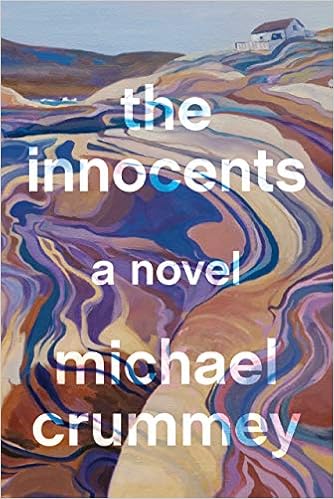Michael Crummey’s novels appear regularly on nomination lists for
Canada’s major literary awards and international ones as well. Though just published, this book is no
exception.
Ada and Evered Best, aged around 9 and 11 respectively, are orphaned
and left to fend for themselves in an isolated cove in northern
Newfoundland. Their only contact with
people is during the biannual visit of a supply ship. Their lives are shaped by the “ratcheting
wheel of the seasons” (88): spring ice
break-up, planting and harvesting a garden, the arrival of the caplin and then
the cod, berry-picking, storing provisions for winter. Theirs is a story of surviving food
shortages, cold winters, ferocious storms, illness, and accidents. The lesson that they learn perhaps more than
any other is that “A body must bear what can’t be helped” (6, 24, 280).
Ada and Evered know virtually nothing of the world outside the cove and
their survival skills are limited to knowledge acquired by watching their parents: “They were left together in the cove then
with its dirt-floored stud tilt, with its garden of root vegetables and its
scatter of outbuildings, with its looming circle of hills and rattling brook
and its view of the ocean’s grey expanse beyond the harbour skerries. The cove was the heart and sum of all
creation in their eyes and they were alone there with the little knowledge of
the world passed on haphazard and gleaned by chance” (5).
As little as they know of the world, they know perhaps even less about their
bodies. Ada knows almost nothing about
menstruation and even less about sex and its role in conception. As he approaches adolescence, Evered becomes
subject to impulses he doesn’t understand but that engender “Pleasure and
shame. Shame and pleasure” (260).
From the beginning, what motivates them is their loyalty to each
other. The two manage to kill a seal and
gorge on the fresh meat: “Ada’s pale
face was raw and her eyes red with the crying she’d done in the cold but there
was an unmistakable glim of light beneath the skin, a look that redeemed every
interminable hour Evered had spent exposed to the weather on the point”
(42). As time passes, their connection
is complicated by the onset of sexual maturity, and they grow apart: “They had all their lives been the one thing
the other looked to first and last, the one article needed to feel complete
whatever else was taken from them or mislaid in the dark. But each in their own way was beginning to
doubt their pairing was requisite to what they might want from life” (240).
Over time, they come to understand how complex people are. Ada comes “to suspect a person might not be
one simple thing, uniform and constant” (232).
Evered realizes that he cannot ever truly know his sister; he sees her
vague silhouette in the dark and “he thought it was a genuine picture of Ada,
that it was as true a sight as a person could hope to take of another in this
life. That anything more was gossip and
fairy tale, umbrage, wishful thinking” (257).
Ada realizes that her brother can be light-hearted at the same time as
he is privy to unspeakable acts committed in desperation and thinks, “It hardly
seemed possible both those experiences could inhabit the same frame at the one
time. They should be different people,
she thought, those boys” (237). And
Evered himself thinks he behaves like two different people: “he’d shed lark for another plumage
altogether” (268).
I was really wanting to learn more of the parents’ story. Interesting tidbits are dropped like “the
folly of couples being unevenly yoked” and “the burden of unknown
transgressions” (56), suggestions that Sarah Best was a Catholic, who “would
not submit to having her children baptized outside the Papist church” (63), and
a tale of two brothers (225 – 227) which Evered cannot totally discount (281-
282). Of course, the children know nothing of their
parents’ origins, so the reader is ignorant and confused and so experiences what
Ada and Evered experience.
Ada is a fascinating character. She
is such an innocent that she thinks reading “’was something you was born
knowing . . . or not knowing’” (233).
When she understands that she can be taught, she desperately wants
that. She is attracted by beauty; she
collects objects she considers beautiful, even stealing a bone pendant from a
Beothuk burial site. Later, she culls “the
shells and rocks and feathers that had lost their lustre, objects that had once
possessed a hit of magic or beauty or mystery and now seemed merely
ordinary. It was confounding to see
magic and beauty and mystery leach out of a thing, to think it could be used up
like a store of winter supplies” (184).
I found this last sentence to be so very sad.
In the Acknowledgements, Crummey mentions The Dictionary of Newfoundland English as “a long-time source of
inspiration and information” and suggests that his novel “would be a different
and lesser thing without it.” I have to agree. I found myself making a list of Newfoundland
words like dwy and gut-foundered. And I understand how the Dictionary of the Vulgar Tongue offered words like blowsabella and madge cull and a description of joining
giblets.
I certainly recommend this book, the story of “a pair of childish
vagabonds passing through an abandoned northern kingdom” (111). It is often an uncomfortable read since they
are two innocents “abandoned [like] the blind cub to the indiscriminate work of
nature” (178). It is both heart-breaking
and thought-provoking.

No comments:
Post a Comment